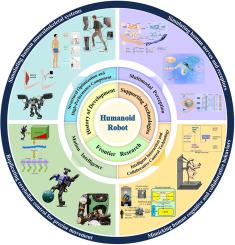Orchestrating mechanics, perception and control: Enabling embodied intelligence in humanoid robots
IF 6.9
1区 管理学
Q1 COMPUTER SCIENCE, INFORMATION SYSTEMS
引用次数: 0
Abstract
Humanoid robotics has evolved from early bipedal locomotion studies to modern systems integrating neuromorphic intelligence. This review systematically examines nearly 300 research studies, identifying key advancements in biomechanical optimization, multimodal perception, motion intelligence, and intelligent interaction. Recent progress in biomechanical optimization through material-structure co-design has led to lighter, more adaptive robotic frameworks, improving energy efficiency, compliance, and mechanical robustness. Meanwhile, multimodal perception has significantly enhanced environmental understanding by integrating vision, force, and proprioceptive sensing, enabling robust scene interpretation and adaptive interaction. However, challenges remain in real-time sensor fusion and uncertainty handling, limiting performance in dynamic and unstructured environments. Advancements in motion intelligence are increasingly driven by frameworks that integrate model-based control with learning-driven adaptation, allowing humanoid robots to achieve greater efficiency, agility, and generalizability in motion planning and execution. At the same time, intelligent interaction has evolved with approaches such as imitation learning, shared control, brain-computer interfaces, teleoperation, and large models, strengthening the link between perception and action for seamless human-robot collaboration. While these innovations enhance adaptability and interaction efficiency, robustness in intent-driven decision-making and real-world deployment remains a key challenge. Commercialization efforts have accelerated the transition from laboratory prototypes to practical applications, particularly in industrial automation and assistive robotics. However, scalability, autonomy, and safety remain critical concerns, requiring further advancements in hardware efficiency, neuromorphic computing, and AI-driven architectures. By synthesizing theoretical insights with recent technological developments, this review provides a structured roadmap for advancing humanoid robotics toward real-world implementation.

协调机制、感知和控制:使人形机器人具有具身智能
人形机器人已经从早期的两足运动研究发展到集成神经形态智能的现代系统。本文系统地回顾了近300项研究,确定了生物力学优化、多模态感知、运动智能和智能交互方面的关键进展。通过材料-结构协同设计的生物力学优化的最新进展导致了更轻、更自适应的机器人框架,提高了能源效率、顺应性和机械稳健性。同时,多模态感知通过整合视觉、力和本体感觉,显著增强了对环境的理解,实现了强大的场景解释和自适应交互。然而,在实时传感器融合和不确定性处理方面仍然存在挑战,限制了动态和非结构化环境中的性能。运动智能的进步越来越多地受到框架的推动,这些框架将基于模型的控制与学习驱动的适应相结合,使类人机器人在运动规划和执行中实现更高的效率、敏捷性和通用性。与此同时,智能交互也随着模仿学习、共享控制、脑机接口、远程操作和大型模型等方法的发展而发展,加强了感知和行动之间的联系,实现了无缝的人机协作。虽然这些创新增强了适应性和交互效率,但意图驱动决策和实际部署的稳健性仍然是关键挑战。商业化的努力加速了从实验室原型到实际应用的转变,特别是在工业自动化和辅助机器人方面。然而,可扩展性、自主性和安全性仍然是关键问题,需要在硬件效率、神经形态计算和人工智能驱动架构方面取得进一步进展。通过将理论见解与最近的技术发展相结合,本综述为推进人形机器人向现实世界的实现提供了结构化的路线图。
本文章由计算机程序翻译,如有差异,请以英文原文为准。
求助全文
约1分钟内获得全文
求助全文
来源期刊

Information Processing & Management
工程技术-计算机:信息系统
CiteScore
17.00
自引率
11.60%
发文量
276
审稿时长
39 days
期刊介绍:
Information Processing and Management is dedicated to publishing cutting-edge original research at the convergence of computing and information science. Our scope encompasses theory, methods, and applications across various domains, including advertising, business, health, information science, information technology marketing, and social computing.
We aim to cater to the interests of both primary researchers and practitioners by offering an effective platform for the timely dissemination of advanced and topical issues in this interdisciplinary field. The journal places particular emphasis on original research articles, research survey articles, research method articles, and articles addressing critical applications of research. Join us in advancing knowledge and innovation at the intersection of computing and information science.
 求助内容:
求助内容: 应助结果提醒方式:
应助结果提醒方式:


